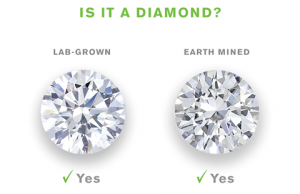The Truth Behind Lab-Grown Diamonds
 A lot of people read the term “lab-grown diamond” and assume that means they are synthetic. The truth behind lab-grown diamonds is much more intricate. A diamond that is made in a lab still has the same chemical makeup as ones that are mined. The Federal Trade Commission decided last summer that lab-mined diamonds can be sold as real diamonds, eliminating the word “natural” from the definition of the jewel:
A lot of people read the term “lab-grown diamond” and assume that means they are synthetic. The truth behind lab-grown diamonds is much more intricate. A diamond that is made in a lab still has the same chemical makeup as ones that are mined. The Federal Trade Commission decided last summer that lab-mined diamonds can be sold as real diamonds, eliminating the word “natural” from the definition of the jewel:
“The Commission no longer defines a ‘diamond’ by using the term ‘natural’ because it is no longer accurate to define diamonds as ‘natural’ when it is now possible to create products that have substantially the same optical, physical, and chemical properties as mined diamonds.”
While lobbyists in the mined diamond industry tried hard to keep lab-grown diamonds from being considered anything but fake and synthetic, the FTC sided with science. This makes diamonds more readily available to the masses and allowing couples from lower socio-economic backgrounds to show their love and commitment with just as beautiful a sparkler.

How are Lab-Grown Diamonds Made?
Lab-grown diamonds are created under the same conditions as those that form beneath the Earth’s crust using real carbon atoms to create a diamond’s trademark crystalline structure, but the process happens in a controlled environment using highly advanced technology.
Labs use two different processes to grow diamonds: High Pressure-High Temperature (HPHT) and Chemical Vapor Deposition (CVD). Here’s exactly how they work:
High-Pressure High-Temperature diamonds

HPHT diamonds begin as little diamond seeds that are placed inside carbon, which are then exposed to temperatures of about 1500 degrees Celsius and pressurized to approximately 1.5 million pounds per square inch using a belt press, a cubic press, or a split-sphere press (BARS). This process mimics the high-pressure, high-temperature environment that occurs in the natural diamond formation process, melting the pure carbon and forming the diamond around the seed. Crystallization occurs over a few weeks, and then the new diamond is cooled.
Chemical Vapor Deposition
A CVD diamond starts its journey inside a sealed vacuum chamber as thinly sliced diamond seed plates that are heated to around 800 degrees Celsius. The chamber is filled with gases rich in carbon such as Methane, whose molecular bonds are then ionized and broken down by a source of energy like a microwave beam or laser breaks. The pure carbon atoms from the broken down gas fall downwards and bind to the seed plates, where they slowly crystallize over several weeks.
Why Buy Lab-Grown Diamonds?
Whether the diamond is formed through HPHT or CVD methods, it will be identical in structure—chemically and physically— to a mined diamond, and there are a lot of reasons to choose a lab-grown diamonds instead. For instance, they are more environmentally sustainable, as it takes considerably less energy to create a diamond in a controlled environment rather than mine one. Price, however, is usually the number one factor for people who choose to go the lab-grown route, as you can save 10-30% and you can find a diamond with a heavier carat weight for a lower price. The Truth Behind Lab-Grown Diamonds is that they ARE real diamonds.
To browse TwoBirch’s selection of engagement ring made with lab-grown diamonds, you can click here!

There are no comments
Add yours